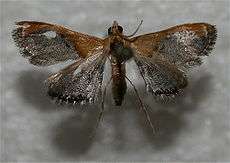Chalcoela iphitalis
| Sooty-winged Chalcoela | |
|---|---|
 | |
.jpg) | |
| Scientific classification | |
| Kingdom: | Animalia |
| Phylum: | Arthropoda |
| Class: | Insecta |
| Order: | Lepidoptera |
| Family: | Crambidae |
| Genus: | Chalcoela |
| Species: | C. iphitalis |
| Binomial name | |
| Chalcoela iphitalis (Walker, 1859)[1] | |
| Synonyms | |
| |
Chalcoela iphitalis, the sooty-winged chalcoela, is a member of the Crambidae family that occurs throughout North America. They are seen as far south as California and South Carolina and as north as Ontario. Adults can be seen from May to August. The head, body and front portion of the forewings are yellow-orange while the hindwing and back portion of the forewings are grey and silver. The back edge of the hindwing has black spots.[2]
The larvae are parasitoid, feeding on the larvae of paper wasps, including species such as Polistes dominulus. Polistes exclamans, Polistes metricus, and Mischocyttarus flavitarsis.[3] For example, M. flavitarsis nests are often invaded by these moths at night because the wasps cannot see them. The moths migrate among the cells, consuming wasp larvae and pupae. They will then lay their larvae, which spin cocoons in empty cells. M. flavitarsis do not attempt to rid the nest of the parasite. Instead, they will continue as a nest or abandon and renest elsewhere.[4]
References
- ↑ "Species Detail". Retrieved 2009-11-27.
- ↑ "Species Chalcoela iphitalis - Sooty-winged Chalcoela - Hodges#4895". Retrieved 2009-11-27.
- ↑ A. A. Madden, M. M. Davis, P. T. Sparks. 2010. First detailed report of brood parasitoidism in the invasive population of the paper wasp Polistes dominulus (Hymenoptera, Vespidae) in North America. Insect Societies. 57: 257-260.
- ↑ Litte, Marcia (1979). "Mischocyttarus flavitarsis in Arizona: Social and Nesting Biology of a Polistine Wasp". Zeitschrift für Tierpsychologie.